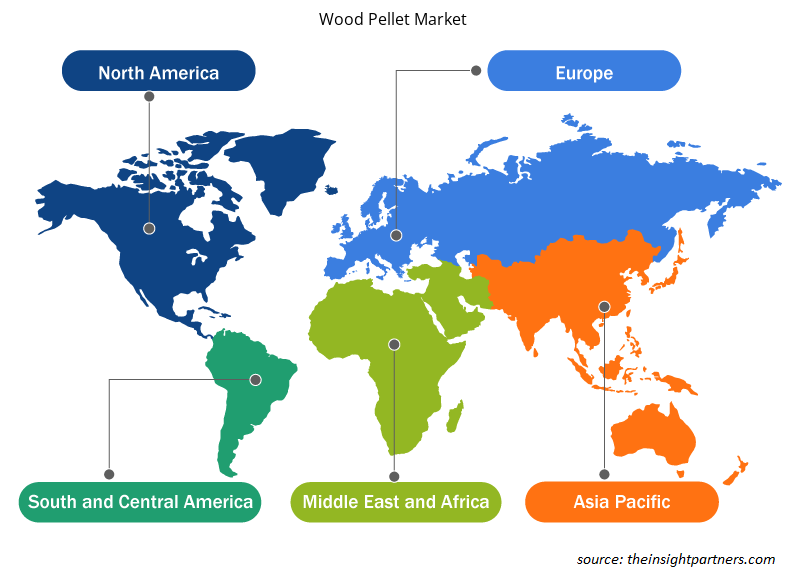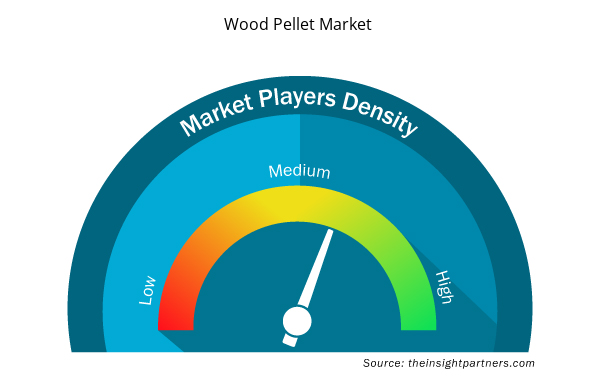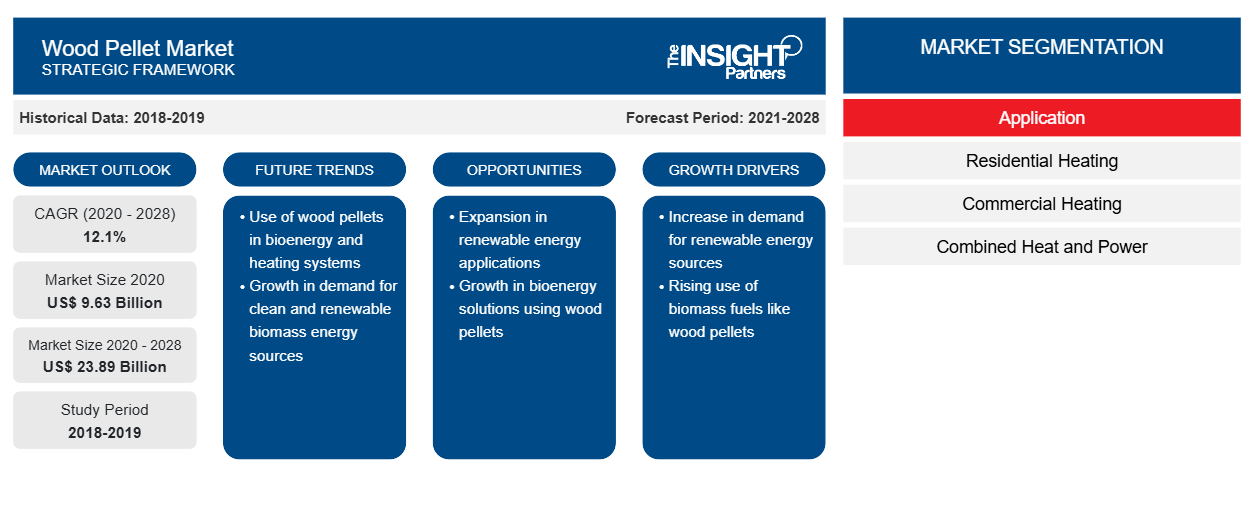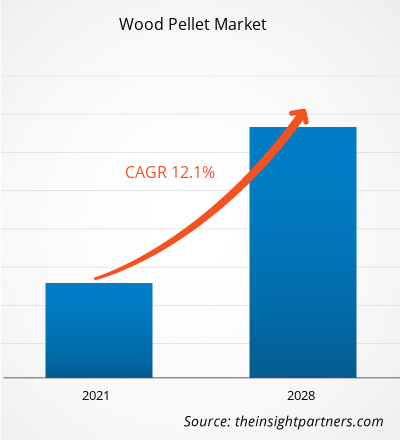Der Markt für Holzpellets wurde im Jahr 2020 auf 9.630,99 Millionen US-Dollar geschätzt und soll bis 2028 23.892,77 Millionen US-Dollar erreichen; von 2021 bis 2028 wird ein durchschnittliches jährliches Wachstum von 12,1 % erwartet.
Holzpellets werden aus fein gemahlener Holzrinde hergestellt und hauptsächlich als Brennstoff verwendet. Sie werden in Wohnhäusern häufig zur effizienten Verbrennung in kleineren Öfen verwendet. Holzpellets werden aus zahlreichen Holzabfallprodukten hergestellt und gelten als erneuerbare Energiequelle. Derzeit werden Holzpellets weltweit neben der Beheizung von Wohnhäusern auch zunehmend zur Stromerzeugung eingesetzt. Sie werden weltweit weitgehend als Brennstoff verwendet, was die Nachfrage nach Holzpellets in den kommenden Jahren voraussichtlich steigern wird. Europa ist die führende Region für den Verbrauch von Holzpellets zur Stromerzeugung. Darüber hinaus ist Nordamerika der wichtigste Exporteur von Holzpellets, was die Produktionskapazitäten für Holzpellets in den kommenden Jahren voraussichtlich erhöhen wird.
Im Jahr 2020 hatte Europa den größten Anteil am Weltmarkt. Ein Jahresbericht, der beim Global Agriculture Information Network des USDA Foreign Agricultural Service eingereicht wurde, zeigt, dass der Holzpelletmarkt in Europa von der COVID-19-Pandemie relativ unberührt geblieben ist. Dem Bericht zufolge verbrauchte die Region im Jahr 2018 etwa 29 Millionen Tonnen Holzpellets, was sie zum weltweit größten Pelletmarkt macht. Holzpellets werden in Wohngebäuden zu Heizzwecken und zur industriellen Wärme- und Stromerzeugung verwendet. Der Bericht besagt weiter, dass die Region derzeit etwa 30 % zur weltweiten Pelletproduktion beiträgt. Sie macht jedoch den größten Verbrauch von Holzpellets weltweit aus. Italien, Deutschland und andere derartige Länder gelten als die wichtigsten Wachstumsmärkte für den Verbrauch von Holzpellets in Wohngebäuden. Großbritannien ist einer der größten Verbraucher von Holzpellets, gefolgt von Italien und Dänemark.
Der globale Markt für Holzpellets war durch die Auswirkungen des COVID-19-Ausbruchs mit vielen Herausforderungen konfrontiert. Die anhaltende COVID-19-Pandemie hat den Status des Chemie- und Materialsektors drastisch verändert und sich negativ auf das Wachstum des Holzpelletsmarktes ausgewirkt. Die Umsetzung von Maßnahmen zur Bekämpfung der Ausbreitung des Virus hat die Situation verschärft und das Wachstum mehrerer Industriezweige beeinträchtigt. Der Markt wurde durch die plötzliche Verzerrung der Betriebseffizienz und Störungen der Wertschöpfungsketten beeinflusst, die auf die plötzliche Schließung nationaler und internationaler Grenzen zurückzuführen sind. Störungen bei der Beschaffung von Rohstoffen von Lieferanten und vorübergehende Schließungen von Produktionsstandorten aufgrund unbefristeter Sperrungen und vorübergehender Quarantänen haben das Wachstum des Marktes während der Pandemie beeinträchtigt. Laut einer am 30. Juli 2020 von Woodcote Media Ltd veröffentlichten Nachricht ergab eine von ENplus, einem Zertifizierungssystem für Holzpellets, durchgeführte Umfrage, dass 75 % der zertifizierten Hersteller von der COVID-19-Pandemie negativ betroffen waren. Die Unternehmen planen, die Preise für Holzpellets für Endverbraucher zu überarbeiten. Derselbe Bericht geht jedoch davon aus, dass etwa 5 % der Befragten der Meinung sind, dass die Nachfrage nach Holzpellets seitens der Endverbraucher leicht steigt. Ebenso wurde die Holzversorgungskette durch die Pandemie beeinträchtigt, was zu Störungen bei der Rohstoffversorgung und den Preisen führte.
Passen Sie diesen Bericht Ihren Anforderungen an
Sie erhalten kostenlos individuelle Anpassungen an jedem Bericht, einschließlich Teilen dieses Berichts oder einer Analyse auf Länderebene, eines Excel-Datenpakets sowie tolle Angebote und Rabatte für Start-ups und Universitäten.
- Holen Sie sich die wichtigsten Markttrends aus diesem Bericht.Dieses KOSTENLOSE Beispiel umfasst eine Datenanalyse von Markttrends bis hin zu Schätzungen und Prognosen.
Markteinblicke
Wachsendes Bewusstsein für die Nutzung erneuerbarer Energiequellen
Erneuerbare Energien spielen eine entscheidende Rolle bei der Deckung des zukünftigen Energiebedarfs in ländlichen und städtischen Gebieten. Die Ressourcenknappheit und das zunehmende Bewusstsein für die negativen Umweltauswirkungen fossilbasierter Produkte und Prozesse haben die Abhängigkeit von erneuerbaren Energiequellen wie Holzpellets stark erhöht. Der wachsende Bedarf an nachhaltiger Energieentwicklung ist ein weiterer Faktor, der zur steigenden Nachfrage nach Holzpellets beiträgt. Erneuerbare Energiequellen und -technologien gelten als umweltfreundliche Alternativen, da sie im Vergleich zu anderen Energiequellen im Allgemeinen nur geringe oder keine Auswirkungen auf die Umwelt haben. Darüber hinaus sind solche Ressourcen leicht verfügbar und können nicht erschöpft werden.
Holzpellets werden als erneuerbare Energiequellen eingestuft, da sie aus Bäumen gewonnen werden und eine Form von Biomasse sind. Holzpellets bestehen aus getrockneten und komprimierten Holzfasern, die aus Sägewerksresten, Holzabfällen wie Waldabfällen und ganzen Baumstämmen hergestellt werden. Laut der US Energy Information Administration wird Biomasse als organisches Material eingestuft, das effektiv als Energiequelle genutzt werden kann. Mehrere Formen von Biomasse wie Holzpellets sind kohlenstoffneutral und hinterlassen beim Verbrennen von Biomasse einen Netto-Null-CO2-Fußabdruck.
Typ-Einblicke
Basierend auf der Anwendung ist der globale Markt für Holzpellets in Wohnheizung, Gewerbeheizung, Kraft-Wärme-Kopplung (KWK) und Stromerzeugung unterteilt. Das Segment Wohnheizung führte den globalen Markt für Holzpellets im Jahr 2020 an. Holzbefeuerte Systeme werden weltweit häufig zur Beheizung von Wohnhäusern verwendet, und in letzter Zeit haben Holzpellets traditionelles Brennholz ersetzt. Holzpelletkessel für Wohnheizungen versprechen geringe Emissionen, hohe Effizienz und automatischen Betrieb. Holzpellets werden zur Beheizung von Wohnhäusern in Pelletöfen verwendet. Sie werden auch in Pelletkesseln zur Erzeugung von Wärme, Dampf und Strom in der Dienstleistungsbranche, der Stromerzeugung und im verarbeitenden Gewerbe verwendet. Sie werden zur Strom- und Wärmeerzeugung im verarbeitenden Gewerbe und im Energiesektor verwendet, was den Markt für Holzpellets antreibt. Da die Kosten für Holzpellets lange Zeit niedriger blieben als die anderer Brennstoffe, werden sie zu einer wirtschaftlicheren Option, die das Hauptanliegen des Wohnsektors anspricht. Als erneuerbare Energiequelle hatten Holzpellets in mehreren Ländern Anreize und Subventionen von den Regierungen erhalten. In den letzten Jahren haben viele Länder ihre Richtlinien und Programme in Bezug auf Holzpellets für Heizzwecke eingeführt oder aktualisiert.
Zu den wichtigsten Marktteilnehmern auf dem Holzpelletmarkt gehören Pacific BioEnergy, Premium Pellet Ltd., Pinnacle Renewable Energy, Enviva, ANDRITZ, Wood & Sons, Graanul Invest, New England Wood Pellet, TANAC und Energex Pellet Fuel, Inc.
Bericht-Spotlights
- Fortschrittliche Branchentrends auf dem globalen Holzpelletmarkt helfen den Akteuren bei der Entwicklung wirksamer langfristiger Strategien
- In Industrie- und Entwicklungsländern angewandte Strategien für Unternehmenswachstum
- Quantitative Analyse des globalen Holzpelletmarktes von 2019 bis 2028
- Schätzung der Nachfrage nach Holzpellets in verschiedenen Branchen
- PEST-Analyse zur Veranschaulichung der Wirksamkeit der in der Branche tätigen Käufer und Lieferanten bei der Vorhersage des Marktwachstums
- Aktuelle Entwicklungen zum Verständnis des Wettbewerbsmarktszenarios und der Nachfrage nach Holzpellets
- Markttrends und -aussichten sowie Faktoren, die das Wachstum des Holzpelletmarktes vorantreiben und bremsen
- Entscheidungsprozess durch das Verständnis von Strategien, die das kommerzielle Interesse im Hinblick auf das Wachstum des globalen Holzpelletmarktes untermauern
- Größe des Holzpelletmarktes an verschiedenen Marktknoten
- Detaillierte Übersicht und Segmentierung des globalen Holzpelletmarktes sowie seiner Dynamik in der Branche
- Marktgröße für Holzpellets in verschiedenen Regionen mit vielversprechenden Wachstumschancen
Regionale Einblicke in den Holzpelletmarkt
Die regionalen Trends und Faktoren, die den Holzpelletmarkt im Prognosezeitraum beeinflussen, wurden von den Analysten von Insight Partners ausführlich erläutert. In diesem Abschnitt werden auch die Marktsegmente und die Geografie des Holzpelletmarkts in Nordamerika, Europa, im asiatisch-pazifischen Raum, im Nahen Osten und Afrika sowie in Süd- und Mittelamerika erörtert.

- Erhalten Sie regionale Daten zum Holzpelletmarkt
Umfang des Holzpellet-Marktberichts
| Berichtsattribut | Details |
|---|---|
| Marktgröße im Jahr 2020 | 9,63 Milliarden US-Dollar |
| Marktgröße bis 2028 | 23,89 Milliarden US-Dollar |
| Globale CAGR (2020 - 2028) | 12,1 % |
| Historische Daten | 2018-2019 |
| Prognosezeitraum | 2021-2028 |
| Abgedeckte Segmente | Nach Anwendung
|
| Abgedeckte Regionen und Länder | Nordamerika
|
| Marktführer und wichtige Unternehmensprofile |
|
Dichte der Marktteilnehmer für Holzpellets: Auswirkungen auf die Geschäftsdynamik verstehen
Der Markt für Holzpellets wächst rasant, angetrieben durch die steigende Nachfrage der Endverbraucher aufgrund von Faktoren wie sich entwickelnden Verbraucherpräferenzen, technologischen Fortschritten und einem größeren Bewusstsein für die Vorteile des Produkts. Mit steigender Nachfrage erweitern Unternehmen ihr Angebot, entwickeln Innovationen, um die Bedürfnisse der Verbraucher zu erfüllen, und nutzen neue Trends, was das Marktwachstum weiter ankurbelt.
Die Marktteilnehmerdichte bezieht sich auf die Verteilung der Firmen oder Unternehmen, die in einem bestimmten Markt oder einer bestimmten Branche tätig sind. Sie gibt an, wie viele Wettbewerber (Marktteilnehmer) in einem bestimmten Marktraum im Verhältnis zu seiner Größe oder seinem gesamten Marktwert präsent sind.
Die wichtigsten auf dem Holzpelletmarkt tätigen Unternehmen sind:
- Pacific BioEnergy
- Premium Pellet Ltd.
- Pinnacle Erneuerbare Energien
- Enviva
- ANDRITZ
Haftungsausschluss : Die oben aufgeführten Unternehmen sind nicht in einer bestimmten Reihenfolge aufgeführt.

- Überblick über die wichtigsten Akteure auf dem Holzpelletmarkt
Der Bericht segmentiert den globalen Holzpelletmarkt wie folgt:
Holzpelletmarkt, nach Anwendung
- Nach Anwendung ist der globale Markt für Holzpellets in Wohnheizung, Gewerbeheizung, Kraft-Wärme-Kopplung (KWK) und Stromerzeugung segmentiert.
Firmenprofile
- Pacific BioEnergy
- Premium Pellet Ltd.
- Pinnacle Erneuerbare Energien
- Enviva
- ANDRITZ
- Holz & Söhne
- Graanul Invest
- Neuengland Holzpelletv5/8520
- TANAC
- Energex Pellet Fuel, Inc.
- Historische Analyse (2 Jahre), Basisjahr, Prognose (7 Jahre) mit CAGR
- PEST- und SWOT-Analyse
- Marktgröße Wert/Volumen – Global, Regional, Land
- Branche und Wettbewerbsumfeld
- Excel-Datensatz



Report Coverage
Revenue forecast, Company Analysis, Industry landscape, Growth factors, and Trends

Segment Covered
This text is related
to segments covered.

Regional Scope
North America, Europe, Asia Pacific, Middle East & Africa, South & Central America

Country Scope
This text is related
to country scope.
Häufig gestellte Fragen
Asia Pacific is estimated to register the fastest CAGR in the market over the forecast period. Rising industrialization and urbanization in these countries offer ample opportunities for the key market players. The wood pellet industry in APAC countries has experienced a considerable shift over the years. The massive market growth in the region is attributed to the rising investments in sustainable and bio-based solutions in economies, such as India and China. Furthermore, favorable government policies attract new and international players to set their wood pellet manufacturing plants across China, India, and Japan.
Wood-fuelled systems are commonly used worldwide for residential heating, and recently wood pellets have been replacing traditional firewood. Wood pellet boilers for residential heating applications promise low emissions, high efficiency, and automatic operation. Wood pellets are used for residential heating in pellet stoves and pellet boilers to generate heat, steam, and electricity in the service industry, power generation, and manufacturing. It is used for power generation and heat generation in the manufacturing and energy sectors, which is driving the wood pellet market. Since the cost of wood pellets remained cheaper than that of other fuels for a long time, it becomes a more economical option, addressing the primary concern of the residential sectors. As a renewable energy source, wood pellets had received incentives and subsidies from the governments in many countries.
The major players operating in the wood pellet market are ANDRITZ, Energex Pellet Fuel, Inc., Enviva, New England Wood Pellet LLC, Pacific BioEnergy, Pinnacle Renewable Energy Inc, Premium Pellet Ltd., Graanul Invest, Wood & Sons, and TANAC.
In 2021, Europe held the largest revenue share of the global wood pellet market. An annual report filed with the USDA Foreign Agricultural Service’s Global Agriculture Information Network represents that the wood pellet market in Europe has been relatively unaffected by the COVID-19 pandemic. As per the report, the region consumed ~29 million metric tons of wood pellets in 2018, which makes it the world’s largest pellet market. Wood pellets are used in residential applications for heating purposes and industrial heat and power generation. The report further states that the region contributes ~30% of world pellet production currently. However, it accounts for the major consumption of wood pellets across the globe. Italy, Germany, and other such countries are considered as the major growth markets for consuming wood pellets in residential heating applications. The UK is one of the major consumers of wood pellets, followed by Italy and Denmark.
Trends and growth analysis reports related to Chemicals and Materials : READ MORE..
The List of Companies - Wood Pellet Market
- Pacific BioEnergy
- Premium Pellet Ltd.
- Pinnacle Renewable Energy
- Enviva
- ANDRITZ
- Wood & Sons
- Graanul Invest
- New England Wood Pellet
- TANAC
- Energex Pellet Fuel, Inc.
The Insight Partners performs research in 4 major stages: Data Collection & Secondary Research, Primary Research, Data Analysis and Data Triangulation & Final Review.
- Data Collection and Secondary Research:
As a market research and consulting firm operating from a decade, we have published and advised several client across the globe. First step for any study will start with an assessment of currently available data and insights from existing reports. Further, historical and current market information is collected from Investor Presentations, Annual Reports, SEC Filings, etc., and other information related to company’s performance and market positioning are gathered from Paid Databases (Factiva, Hoovers, and Reuters) and various other publications available in public domain.
Several associations trade associates, technical forums, institutes, societies and organization are accessed to gain technical as well as market related insights through their publications such as research papers, blogs and press releases related to the studies are referred to get cues about the market. Further, white papers, journals, magazines, and other news articles published in last 3 years are scrutinized and analyzed to understand the current market trends.
- Primary Research:
The primarily interview analysis comprise of data obtained from industry participants interview and answers to survey questions gathered by in-house primary team.
For primary research, interviews are conducted with industry experts/CEOs/Marketing Managers/VPs/Subject Matter Experts from both demand and supply side to get a 360-degree view of the market. The primary team conducts several interviews based on the complexity of the markets to understand the various market trends and dynamics which makes research more credible and precise.
A typical research interview fulfils the following functions:
- Provides first-hand information on the market size, market trends, growth trends, competitive landscape, and outlook
- Validates and strengthens in-house secondary research findings
- Develops the analysis team’s expertise and market understanding
Primary research involves email interactions and telephone interviews for each market, category, segment, and sub-segment across geographies. The participants who typically take part in such a process include, but are not limited to:
- Industry participants: VPs, business development managers, market intelligence managers and national sales managers
- Outside experts: Valuation experts, research analysts and key opinion leaders specializing in the electronics and semiconductor industry.
Below is the breakup of our primary respondents by company, designation, and region:

Once we receive the confirmation from primary research sources or primary respondents, we finalize the base year market estimation and forecast the data as per the macroeconomic and microeconomic factors assessed during data collection.
- Data Analysis:
Once data is validated through both secondary as well as primary respondents, we finalize the market estimations by hypothesis formulation and factor analysis at regional and country level.
- Macro-Economic Factor Analysis:
We analyse macroeconomic indicators such the gross domestic product (GDP), increase in the demand for goods and services across industries, technological advancement, regional economic growth, governmental policies, the influence of COVID-19, PEST analysis, and other aspects. This analysis aids in setting benchmarks for various nations/regions and approximating market splits. Additionally, the general trend of the aforementioned components aid in determining the market's development possibilities.
- Country Level Data:
Various factors that are especially aligned to the country are taken into account to determine the market size for a certain area and country, including the presence of vendors, such as headquarters and offices, the country's GDP, demand patterns, and industry growth. To comprehend the market dynamics for the nation, a number of growth variables, inhibitors, application areas, and current market trends are researched. The aforementioned elements aid in determining the country's overall market's growth potential.
- Company Profile:
The “Table of Contents” is formulated by listing and analyzing more than 25 - 30 companies operating in the market ecosystem across geographies. However, we profile only 10 companies as a standard practice in our syndicate reports. These 10 companies comprise leading, emerging, and regional players. Nonetheless, our analysis is not restricted to the 10 listed companies, we also analyze other companies present in the market to develop a holistic view and understand the prevailing trends. The “Company Profiles” section in the report covers key facts, business description, products & services, financial information, SWOT analysis, and key developments. The financial information presented is extracted from the annual reports and official documents of the publicly listed companies. Upon collecting the information for the sections of respective companies, we verify them via various primary sources and then compile the data in respective company profiles. The company level information helps us in deriving the base number as well as in forecasting the market size.
- Developing Base Number:
Aggregation of sales statistics (2020-2022) and macro-economic factor, and other secondary and primary research insights are utilized to arrive at base number and related market shares for 2022. The data gaps are identified in this step and relevant market data is analyzed, collected from paid primary interviews or databases. On finalizing the base year market size, forecasts are developed on the basis of macro-economic, industry and market growth factors and company level analysis.
- Data Triangulation and Final Review:
The market findings and base year market size calculations are validated from supply as well as demand side. Demand side validations are based on macro-economic factor analysis and benchmarks for respective regions and countries. In case of supply side validations, revenues of major companies are estimated (in case not available) based on industry benchmark, approximate number of employees, product portfolio, and primary interviews revenues are gathered. Further revenue from target product/service segment is assessed to avoid overshooting of market statistics. In case of heavy deviations between supply and demand side values, all thes steps are repeated to achieve synchronization.
We follow an iterative model, wherein we share our research findings with Subject Matter Experts (SME’s) and Key Opinion Leaders (KOLs) until consensus view of the market is not formulated – this model negates any drastic deviation in the opinions of experts. Only validated and universally acceptable research findings are quoted in our reports.
We have important check points that we use to validate our research findings – which we call – data triangulation, where we validate the information, we generate from secondary sources with primary interviews and then we re-validate with our internal data bases and Subject matter experts. This comprehensive model enables us to deliver high quality, reliable data in shortest possible time.


 Holen Sie sich ein kostenloses Muster für diesen Bericht
Holen Sie sich ein kostenloses Muster für diesen Bericht